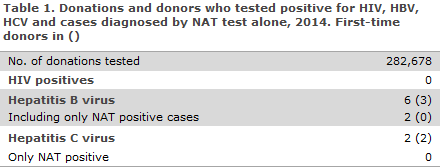No 19 - 2015
Blood donor screening 2014
Ornithosis 2014
Blood donor screening 2014
In 2014 a total of 282,678 units of blood were screened. The number of positive donors is presented in Table 1.
NAT screening (nucleic acid amplification technique) of donor blood for HIV, hepatitis B and C virus (HBV and HCV) was introduced by law on 1 January 2009, EPI-NEWS 2/10.

HIV
No donors tested positive for HIV.
Hepatitis B virus
In 2014, 3 male first-time donors aged 46, 49 and 49 years, respectively, tested positive to HBV. Two persons had been born in hepatitis B endemic areas, and in one case the mode of infection was unknown. One female multiple donor aged 32 years was probably infected through sexual contact in 2014. Another 2 multiple donors tested positive for HBV through NAT screening alone. Both had chronic hepatitis B with no detectable HBsAg, so-called occult hepatitis B.
Hepatitis C virus
In 2014, two female first-time donors aged 46 and 50 years, respectively, tested positive to HCV. Both had been tattooed and pierced, and one had had IV drug use many years previously.
Commentary
The number of donors who tested positive to hepatitis B and C virus markers in Denmark remained low in 2014.
Two donors were NAT positive only to HBV and would therefore not have been detected by the donor screening scheme if NAT screening had not been introduced. Expectedly, some donors will test positive to antibodies to hepatitis B core antigen as they undergo testing, EPI-NEWS 18/13. Such donors will be excluded from making donations in the future, but there are no plans to perform look-back on the large number of blood donations made over the years.
(A.H. Christiansen, S. Cowan, Department of Infectious Disease Epidemiology, L. Harritshøj, H. Ullum, Department of Clinical Immunology, Copenhagen University Hospital (Rigshospitalet)
Ornithosis 2014
In 2014, a total of 16 persons were notified with psittacosis (parrot fever), which is caused by the zoonotic bacterium Chlamydophila psittaci. Among the notified cases, 3 were women and 13 men, and the median age was 57 years (range 33-70 years). A total of 12 were notified as probably infected in Denmark, 2 as probably infected in Sweden and the US and 1 as definitely infected in Greece. In one case, the country if infection was unknown as the patient was a professional fisherman who fell ill during a fishing trip outside of Denmark.
Diagnosis and clinical presentation
All 16 cases had been admitted to hospital, and in 15 cases the diagnosis was confirmed by PCR at the departments of clinical microbiology at Herlev, Hvidovre, Odense University Hospital, Vejle, Skejby and at the SSI, respectively. In 12 cases, the sampling material was lower airway secretion, and in 3 cases it was a swab from the upper airways.
Nine notified cases had pneumonia, including 1 with sepsis. In 6 cases, pneumonia was absent, but a high fever, coughing or influenza-like symptoms were recorded. In one notified case, no information on symptoms was provided.
Disease in the form of coughing and dyspnoea in 2 persons who had been exposed to diseased birds was tested only serologically, and a firm diagnosis of ornithosis was established in none of the tests.
Three were notified as occupationally infected cases. One of these cases was laboratory-confirmed.
A total of 6 were believed to have been infected through cage birds, including 2 parrots. Another 6 cases were believed to have been infected by wild birds. This included 2 persons who had moved ducklings to a new habitat for hunting purposes in their leisure time, and one person who had been infected by garden birds. Furthermore, 3 persons presumably became infected from wild birds through their occupational activity, 1 through pigeons and 2 who worked outdoors, but for whom the source of infection remained unknown. In 4 notified cases, no information on the source of infection was provided.
In 2014, a minor outbreak was recorded which counted 2 epidemically connected notified cases who had bought parrots from the same merchant. The merchant's birds could not be confirmed as the source of the outbreak.
Commentary
The number of notified cases of ornithosis was in line with the numbers observed in the previous years, but in contrast to the previous year the cases were more geographically spread out between regions.
The condition is most frequently diagnosed in middle-aged men, who are primarily infected due to hobby contact to birds. 2014 saw an equal distribution of the number of cases which had presumably been infected through private and/or indoor bird-keeping and from wild birds, respectively.
(C. Kjelsø, Department of Infectious Disease Epidemiology, S. Uldum, Microbiology and Infection Control)
Link to previous issues of EPI-NEWS
6. May 2015